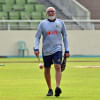Will ICC’s financial move to take cricket to the USA give on-field rewards for fans?

For the better part of the last two decades, various ICC administrative figureheads since the days of Malcolm Speed have talked openly about the desire to have major ICC events in the USA. The motivation was clear: with a rapidly growing South Asian diaspora migrating to cities like New York, Dallas and San Francisco, it made sense for the ICC to want to tap into the market and access their deep pockets.
Online cricket traffic coming out of the USA as well as ICC event ticket purchase credit card sales data further supported the point that there is plenty of money to be made out of fans located in America, who are starved of high-quality cricket action close to home.
But after a generation of lip service, the decision was finally made to back words with deeds in November 2021 when the ICC formally awarded co-hosting rights for the 2024 ICC Men's T20 World Cup to the USA and the West Indies. After three years of build-up, the tournament is set to finally get underway in June at three sites in the USA located in Florida, New York and Texas.
An initial venue bid proposal for the T20 World Cup also included a tentative plan to stage matches at Oakland Coliseum, a 56,000-seat facility in the East Bay of the San Francisco Bay Area. The plan would have centred around using drop-in wickets at a baseball stadium that is home to the Oakland Athletics. However, drop-in wickets would not have been the only logistical challenge. Another challenge was coordinating with Major League Baseball for the Athletics to have an in-season road trip of at least two weeks to squeeze in a window for World Cup matches to be held there.
But the biggest hurdle of all was the time zone difference, because the main point of utilising a stadium of that size was to potentially host the India v Pakistan match there. With so many South Asians immigrants in the area stretching from Napa to Silicon Valley, there is no doubt that the match would have sold out regardless of the price points set for tickets. Yet, with Indian TV broadcasters calling the shots in terms of starting times, it would have required a 7:30am start in California to fit with the desired 8:00pm start times in Mumbai for all of India's matches in the tournament.
Pulling that off on the east coast of America is not as daunting a task, especially since India has successfully played T20Is in Florida at Broward County Stadium with a 10:30am start time during tours against the West Indies held in 2016, 2019, 2022 and 2023. Though the 15,000-seat Lauderhill, Florida facility is one of three venues that was chosen by the ICC to be used for the World Cup, the ICC still wanted to aim for something that would not only accommodate more fans but more eyeballs in a bigger media market like New York.
At first glance, some cricket fans might wonder why Citi Field, home of the New York Mets, is not being utilised. After all, it was the site for the opening match of the 2015 Cricket All-Stars T20 exhibition tour headlined by Sachin Tendulkar and Shane Warne. A drop-in pitch was successfully used for that event. But unlike the expansive layout of Oakland Coliseum, the design of Citi Field puts fan seating very close to the field of play, which made the boundary dimensions for cricket look comically short and wholly unsuitable for an international match.
Another proposal was put forward to have a pop-up stadium at Van Cortlandt Park in the Bronx, a place where amateur club cricket has been played in New York City for more than 100 years. But that plan was shot down by local residents, who rallied against the idea primarily because of extra traffic and noise concerns in the mostly residential neighbourhood where the park is situated.
In spite of more than their fair share of obstacles, the ICC stubbornly refused to give up on the idea of hosting the India v Pakistan match at a big-market venue in the USA. It finally found a willing partner in Nassau County, New York officials to build a pop-up stadium at Eisenhower Park. In a modern architectural marvel, the 34,000-seat modular design venue's construction only began in February this year. Yet, its extraordinary progress has been documented in a series of time-lapse videos to update fans. The drop-in wicket was installed in the last week of April and the venue will be ready by the end of May ahead of the opening match at the venue between South Africa and Sri Lanka on June 3.
Bangladesh will also get to be a part of the unique history of the New York venue when they play South Africa there on June 10. This comes three days after Bangladesh opened their 2024 Men's T20 World Cup slate in Group D against Sri Lanka under the floodlights at Grand Prairie Stadium outside of Dallas, Texas.
It will not have escaped the attention of those paying extra close attention to the tournament schedule that four of the five Full Members out of Asia -- Afghanistan is the lone exception -- have the majority of their group-stage matches scheduled to be played in the USA whereas England and Australia have been placed exclusively at venues in the West Indies. This only further highlights the financial power wielded by the South Asian diaspora in the USA and why 2024 probably won't be the last time that the ICC brings a Cricket World Cup to American soil. Even Nepal, whose ODIs against USA in the summer of 2022 drew more than 1,000 fans to Moosa Stadium just south of Houston, Texas, is expected to draw crowds into the thousands for their World Cup matches against Netherlands at Grand Prairie Stadium on June 4 and Sri Lanka in Florida on June 11.
But one question remains: will any of this help grow cricket's popularity among the mainstream American sports community? The early indications are that if there is any impact in that regard, it will be negligible. Very little promotional work has been done in the lead-up to the T20 World Cup to engage people who are not already hard core cricket fans. In that sense, the reliance of cricket administrators to cater to the existing first and second-generation South Asian immigrant community in America is not only the sport's greatest strength, but also its greatest weakness.
This applies not only to struggles with new fan engagement but also new player participation in America, where cricket is almost exclusively confined to South Asian and other former British Commonwealth expatriate communities. The composition of the 15-man USA squad for the T20 World Cup -- captained by former Gujarat junior player Monank Patel and vice-captained by New York-born, Barbados-raised Aaron Jones – only further highlights that point.
The financial success of having T20 World Cup matches in the USA will never be in doubt. The revenue generated by the India v Pakistan match alone will more than cover the estimated $30 million cost to build the temporary venue at Eisenhower Park. The other seven matches at the venue are the cherry on top and the temporary structure will be torn down soon after the conclusion of the final match at the venue between USA and India on June 12. It means that World Cup memories will remain, but the same can't be said for infrastructure. Whether or not the legacy of hosting the event on American soil spreads to cultivating the next generation of players and fans – instead of just boosting the ICC's bank account – remains to be seen.
Peter Della Penna is the USA correspondent of ESPNcricinfo

 For all latest news, follow The Daily Star's Google News channel.
For all latest news, follow The Daily Star's Google News channel. 








Comments